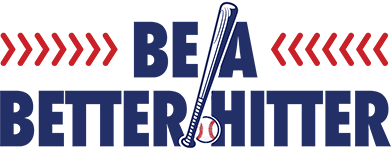Seeing the Ball Part 3: Physical Preparation
1. Stance – The stance is very important. Hitters should be off their heels, knees bent a little, and be in a balanced position. This gives them the confidence in their ability to get out of the way of the ball. A hitter’s stance should allow them to have their head and eyes in good position to see the ball.
2. Consistent Eye Patterns – The hitter must have consistent eye patterns. Beginning with stepping into the batter’s box, your eyes should have the same routine every time, all the time. Example- as you are getting into the batter’s box, most batter’s look to the outside part of the plate to make sure they are where they want to be in the batter’s box. As you look up, your eyes should take the same path to the pitcher. As you are waiting for the pitcher to deliver the ball rest your eyes on him. Look at his belt, his feet, or his hat. This is called “soft focus”, whereby the hitter is not really focused on anything. When he starts his delivery, or goes into his stretch, look at the pitcher’s hat, face or chest, as long as it is close to the release point in a relaxed manner. The concentration level should not be intense at this point. At about the time the pitcher separates his hands, look to the release area. Identify the pitcher’s release point before your turn at bat! The pitcher’s motion should never bother you. The pitcher could bend severely at the waist, throw sidearm or submarine, it doesn’t matter. Your concentration on the release point should be so strong that you are not even aware of the antics during the windup. Your focus is the ball, not the windup.
Many hitters see the ball better off a left-hander instead of a right-hander because they fail to shift their eyes to the different release points. If a hitter is skilled enough to read when a pitcher is tipping his pitches in his delivery, the eye patterns change. However, make sure that the eyes arrive at the release point at about the same time all the time as the pitcher separates the hands. For example, a pitcher might vary his delivery, or change his hand position for a curve ball. The hitter may watch him closely if he is tipping his pitches, before moving his eyes to the release point as the hands break. This time interval must be the same, regardless of whether the hitter is soft focusing, or trying to watch a pitcher tipping his pitches. Make sure the release point, and timing to the release point, is the same. Every time all the time.
3. Big Eyes – Have big eyes as you are tracking the baseball. Squinting causes tension in the face and does not allow the eyes to move as freely as when the face is relaxed. There are some great pictures of hitters such as Wade Boggs, or Don Mattingly when they are hitting the ball, their eyes are as wide as humanly possible. The next time you have a chance to see a photo of yourself hitting a baseball, take a moment to notice your eyes.
4. Follow the ball with your head / Track every pitch – Following the ball with your head and your eyes to the contact zone increases your ability to time every pitch. Your head should be down during the point of contact, with your eyes as level as possible. Your forehead should be down, not your ear. Many young hitters make the mistake of having their head down behind the point of contact, which has a negative effect on the swing. Also, do not look to see where you hit the ball right away. Your head and eyes should come up naturally about the time the bat is finishing it’s path in the follow-through. You may not actually be able to see the ball off the bat (few players do), but your head being in a down position is a much stronger body position and allows you to see the ball for as long as possible.
Remember, consistent eye patterns as you settle into the batter’s box, a soft focus somewhere on the pitcher, followed by an intense focus on the release point as the pitcher breaks the hands.
